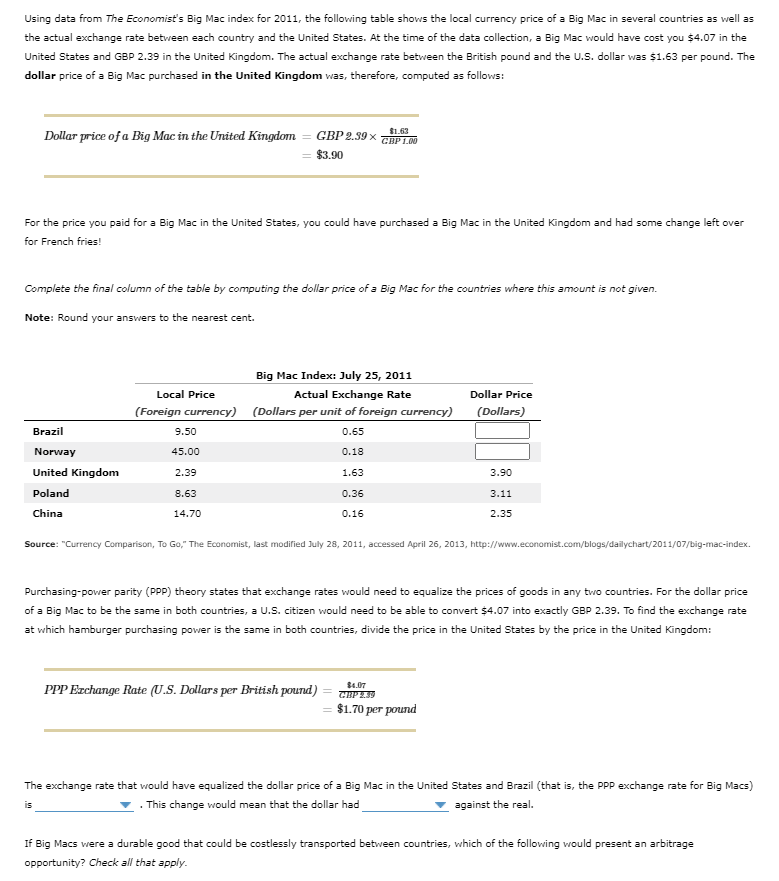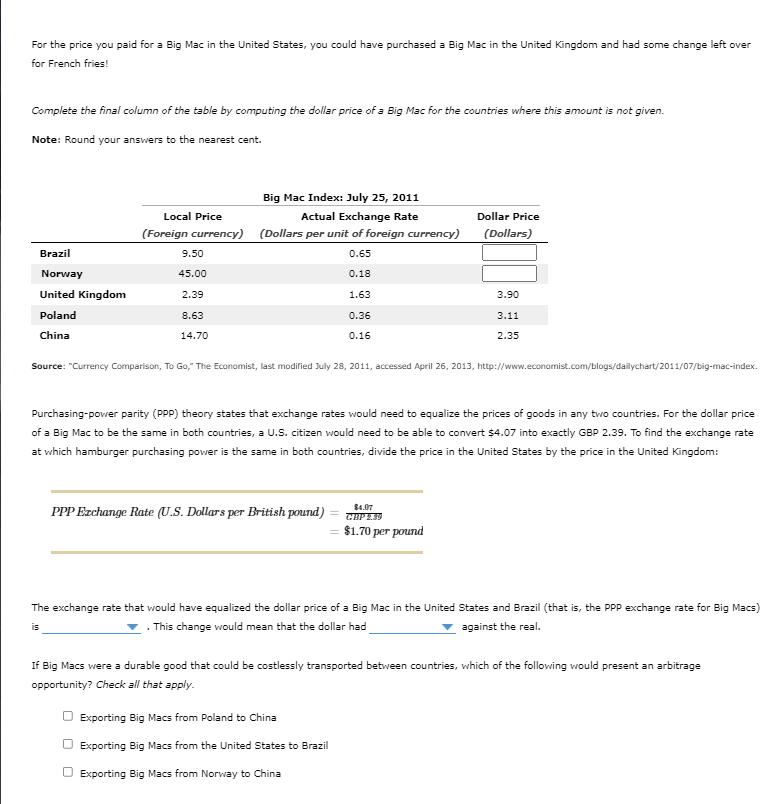Using data from The Economist's Big Mac index for 2011, the following table shows the local currency price of a Big Mac in several countries as well as the actual exchange rate between each country and the United States. At the time of the data collection, a Big Mac would have cost you $4.07 in the United States and GBP 2.39 in the United Kingdom. The actual exchange rate between the British pound and the U.S. dollar was $1.63 per pound. The dollar price of a Big Mac purchased in the United Kingdom was, therefore, computed as follows: NOTE: here are the options for drop down questions for when u get there The exchange rate that would have equalized the dollar price of a Big Mac in the United States and Brazil (that is, the PPP exchange rate for Big Macs) is __________ ($0.43 per real OR $1.96 per deal OR $2.33 per real OR $2.63 per real). This change would mean that the dollar had ________ (appreciated OR depreciated) against the real.
Using data from The Economist's Big Mac index for 2011, the following table shows the local currency price of a Big Mac in several countries as well as the actual exchange rate between each country and the United States. At the time of the data collection, a Big Mac would have cost you $4.07 in the United States and GBP 2.39 in the United Kingdom. The actual exchange rate between the British pound and the U.S. dollar was $1.63 per pound. The dollar price of a Big Mac purchased in the United Kingdom was, therefore, computed as follows: NOTE: here are the options for drop down questions for when u get there The exchange rate that would have equalized the dollar price of a Big Mac in the United States and Brazil (that is, the PPP exchange rate for Big Macs) is __________ ($0.43 per real OR $1.96 per deal OR $2.33 per real OR $2.63 per real). This change would mean that the dollar had ________ (appreciated OR depreciated) against the real.
Brief Principles of Macroeconomics (MindTap Course List)
8th Edition
ISBN:9781337091985
Author:N. Gregory Mankiw
Publisher:N. Gregory Mankiw
Chapter13: Open-economy Macroeconomics: Basic Concepts
Section: Chapter Questions
Problem 8PA
Related questions
Question
Using data from The Economist's Big Mac index for 2011, the following table shows the local currency price of a Big Mac in several countries as well as the actual exchange rate between each country and the United States. At the time of the data collection, a Big Mac would have cost you $4.07 in the United States and GBP 2.39 in the United Kingdom. The actual exchange rate between the British pound and the U.S. dollar was $1.63 per pound. The dollar price of a Big Mac purchased in the United Kingdom was, therefore, computed as follows:
NOTE:
here are the options for drop down questions for when u get there
The exchange rate that would have equalized the dollar price of a Big Mac in the United States and Brazil (that is, the PPP exchange rate for Big Macs) is __________ ($0.43 per real OR $1.96 per deal OR $2.33 per real OR $2.63 per real). This change would mean that the dollar had ________ (appreciated OR depreciated ) against the real.

Transcribed Image Text:Using data from The Economist's Big Mac index for 2011, the following table shows the local currency price of a Big Mac in several countries as well as
the actual exchange rate between each country and the United States. At the time of the data collection, a Big Mac would have cost you $4.07 in the
United States and GBP 2.39 in the United Kingdom. The actual exchange rate between the British pound and the U.S. dollar was $1.63 per pound. The
dollar price of a Big Mac purchased in the United Kingdom was, therefore, computed as follows:
$1.63
Dollar price of a Big Mac in the United Kingdom
GВР 2.89 х
GHP 1.00
$3.90
For the price you paid for a Big Mac in the United States, you could have purchased a Big Mac in the United Kingdom and had some change left over
for French fries!
Complete the final column of the table by computing the dollar price of a Big Mac for the countries where this amount is not given.
Note: Round your answers to the nearest cent.
Big Mac Index: July 25, 2011
Local Price
Actual Exchange Rate
Dollar Price
(Foreign currency) (Dollars per unit of foreign currency)
(Dollars)
Brazil
9.50
0.65
Norway
45.00
0.18
United Kingdom
2.39
1.63
3.90
Poland
8.63
0.36
3.11
China
14.70
0.16
2.35
Source: "Currency Comparison, To Go," The Economist, last modified July 28, 2011, accessed April 26, 2013, http://www.economist.com/blogs/dailychart/2011/07/big-mac-index.
Purchasing-power parity (PPP) theory states that exchange rates would need to equalize the prices of goods in any two countries. For the dollar price
of a Big Mac to be the same in both countries, a U.S. citizen would need to be able to convert $4.07 into exactly GBP 2.39. To find the exchange rate
at which hamburger purchasing power is the same in both countries, divide the price in the United States by the price in the United Kingdom:
$4.07
PPP Ezchange Rate (U.S. Dollars per British pound)
$1.70 per pound
The exchange rate that would have equalized the dollar price of a Big Mac in the United States and Brazil (that is, the PPP exchange rate for Big Macs)
. This change would mean that the dollar had
against the real.
is
If Big Macs were a durable good that could be costlessly transported between countries, which of the following would present an arbitrage
opportunity? Check all that apply.

Transcribed Image Text:For the price you paid for a Big Mac in the United States, you could have purchased a Big Mac in the United Kingdom and had some change left over
for French fries!
Complete the final column of the table by computing the dollar price of a Big Mac for the countries where this amount is not given.
Note: Round your answers to the nearest cent.
Big Mac Index: July 25, 2011
Local Price
Actual Exchange Rate
Dollar Price
(Foreign currency) (Dollars per unit of foreign currency)
(Dollars)
Brazil
9.50
0.65
Norway
45.00
0.18
United Kingdom
2.39
1.63
3.90
Poland
8.63
0.36
3.11
China
14.70
0.16
2.35
Source: "Currency Comparison, To Go," The Economist, last modified July 28, 2011, accessed April 26, 2013, http://www.economist.com/blogs/dailychart/2011/07/big-mac-index.
Purchasing-power parity (PPP) theory states that exchange rates would need to equalize the prices of goods in any two countries. For the dollar price
of a Big Mac to be the same in both countries, a U.S. citizen would need to be able to convert $4.07 into exactly GBP 2.39. To find the exchange rate
at which hamburger purchasing power is the same in both countries, divide the price in the United States by the price in the United Kingdom:
$4.07
PPP Ezchange Rate (U.S. Dollars per British pound)
= $1.70 per pound
The exchange rate that vwould have equalized the dollar price of a Big Mac in the United States and Brazil (that is, the PPP exchange rate for Big Macs)
is
. This change would mean that the dollar had
against the real.
If Big Macs were a durable good that could be costlessly transported between countries, which of the following would present an arbitrage
opportunity? Check all that apply.
Exporting Big Macs from Poland to China
O Exporting Big Macs from the United States to Brazil
O Exporting Big Macs from Norway to China
Expert Solution
This question has been solved!
Explore an expertly crafted, step-by-step solution for a thorough understanding of key concepts.
This is a popular solution!
Trending now
This is a popular solution!
Step by step
Solved in 3 steps

Knowledge Booster
Learn more about
Need a deep-dive on the concept behind this application? Look no further. Learn more about this topic, economics and related others by exploring similar questions and additional content below.Recommended textbooks for you

Brief Principles of Macroeconomics (MindTap Cours…
Economics
ISBN:
9781337091985
Author:
N. Gregory Mankiw
Publisher:
Cengage Learning

Principles of Economics (MindTap Course List)
Economics
ISBN:
9781305585126
Author:
N. Gregory Mankiw
Publisher:
Cengage Learning

Principles of Macroeconomics (MindTap Course List)
Economics
ISBN:
9781305971509
Author:
N. Gregory Mankiw
Publisher:
Cengage Learning

Brief Principles of Macroeconomics (MindTap Cours…
Economics
ISBN:
9781337091985
Author:
N. Gregory Mankiw
Publisher:
Cengage Learning

Principles of Economics (MindTap Course List)
Economics
ISBN:
9781305585126
Author:
N. Gregory Mankiw
Publisher:
Cengage Learning

Principles of Macroeconomics (MindTap Course List)
Economics
ISBN:
9781305971509
Author:
N. Gregory Mankiw
Publisher:
Cengage Learning

Managerial Economics: A Problem Solving Approach
Economics
ISBN:
9781337106665
Author:
Luke M. Froeb, Brian T. McCann, Michael R. Ward, Mike Shor
Publisher:
Cengage Learning

Economics: Private and Public Choice (MindTap Cou…
Economics
ISBN:
9781305506725
Author:
James D. Gwartney, Richard L. Stroup, Russell S. Sobel, David A. Macpherson
Publisher:
Cengage Learning

Macroeconomics: Private and Public Choice (MindTa…
Economics
ISBN:
9781305506756
Author:
James D. Gwartney, Richard L. Stroup, Russell S. Sobel, David A. Macpherson
Publisher:
Cengage Learning